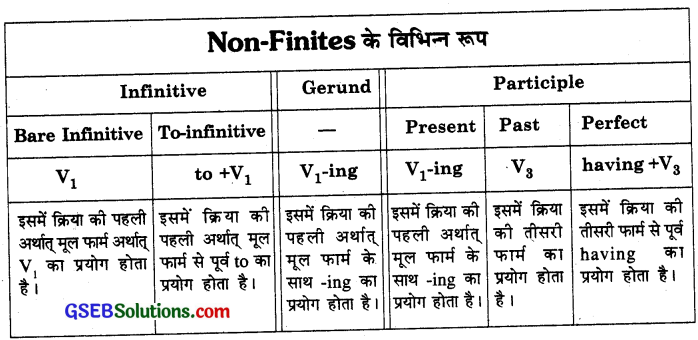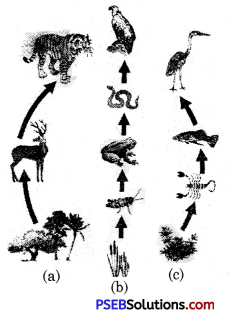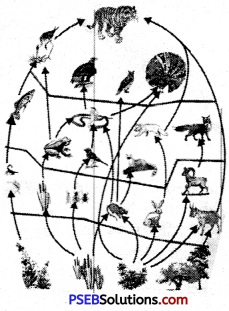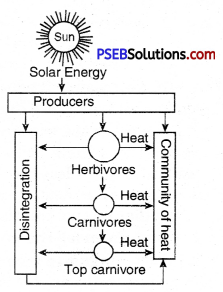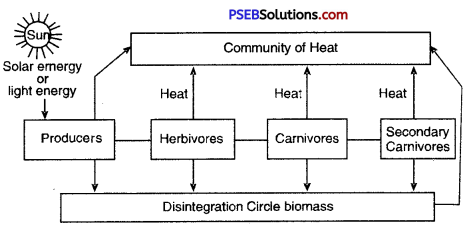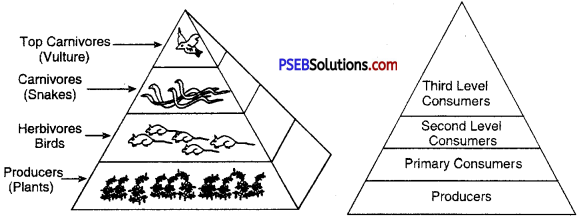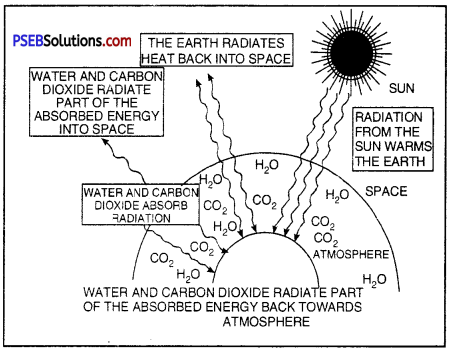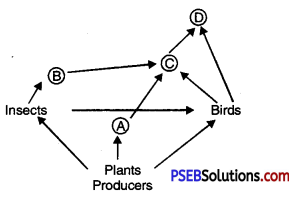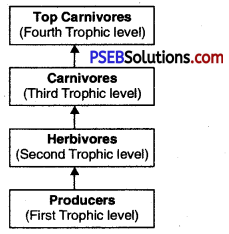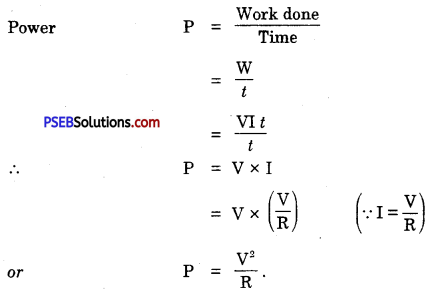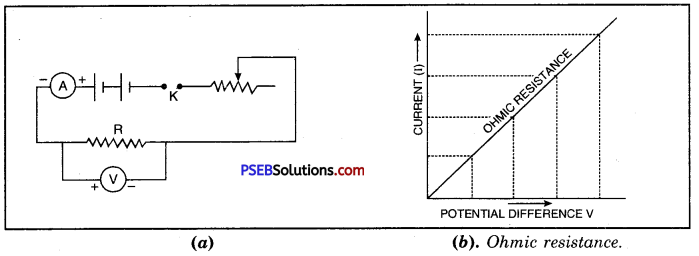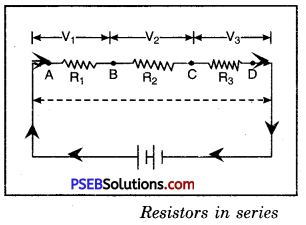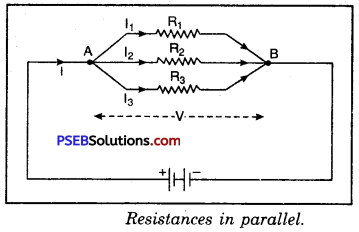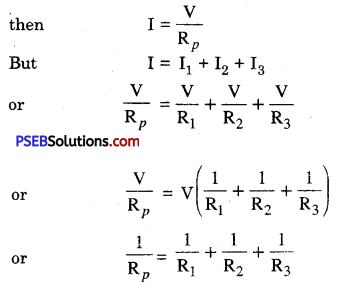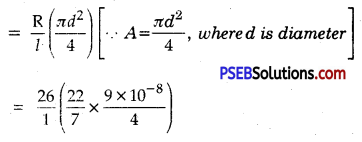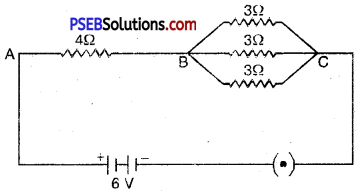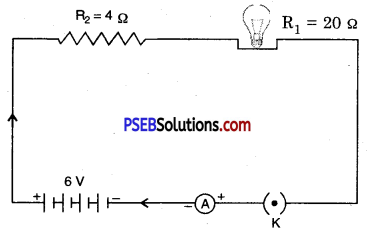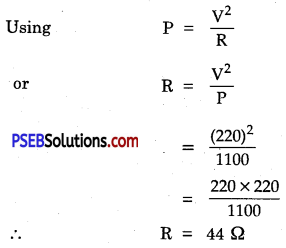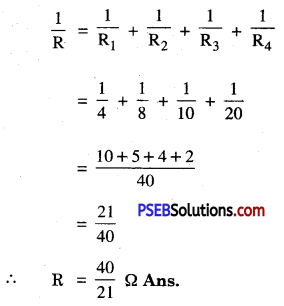Punjab State Board PSEB 10th Class Hindi Book Solutions Chapter 14 राजेन्द्र बाबू Textbook Exercise Questions and Answers.
PSEB Solutions for Class 10 Hindi Chapter 14 राजेन्द्र बाबू
Hindi Guide for Class 10 PSEB राजेन्द्र बाबू Textbook Questions and Answers
(क) विषय बोध
I. निम्नलिखित प्रश्नों के उत्तर एक या दो पंक्तियों में दीजिए
प्रश्न 1.
राजेंद्र बाबू को लेखिका ने प्रथम बार कहाँ देखा था?
उत्तर:
राजेंद्र बाबू को लेखिका ने सबसे पहले पटना के स्टेशन पर एक बेंच पर बैठे देखा था।
प्रश्न 2.
राजेंद्र बाबू अपने स्वभाव और रहन-सहन में किसका प्रतिनिधित्व करते थे?
उत्तर:
राजेंद्र बाबू अपने स्वभाव और रहन-सहन में एक सामान्य भारतीय या भारतीय कृषक का प्रतिनिधित्व करते थे।
![]()
प्रश्न 3.
राजेंद्र बाबू के निजी सचिव और सहचर कौन थे?
उत्तर:
राजेंद्र बाबू के निजी सचिव और सहचर भाई चक्रधर जी थे।
प्रश्न 4.
राजेंद्र बाबू ने किनकी शिक्षा की व्यवस्था करने के लिए लेखिका से अनुरोध किया?
उत्तर:
राजेंद्र बाबू ने अपनी 15-16 पौत्रियों की शिक्षा की व्यवस्था करने के लिए लेखिका से अनुरोध किया था।
प्रश्न 5.
लेखिका प्रयाग से कौन-सा उपहार लेकर राष्ट्रपति भवन पहुंची थी?
उत्तर:
लेखिका प्रयाग से बारह सूपों का उपहार लेकर राष्ट्रपति भवन पहुंची थी।
प्रश्न 6.
राष्ट्रपति को उपवास की समाप्ति पर क्या खाते देखकर लेखिका को हैरानी हुई?
उत्तर:
राष्ट्रपति के उपवास की समाप्ति पर कुछ उबले हुए आलू खाकर परायण करते हैरानी हुई थी।
II. निम्नलिखित प्रश्नों के उत्तर तीन या चार पंक्तियों में दीजिए
प्रश्न 1.
राजेंद्र बाबू को देखकर हर किसी को यह क्यों लगता था कि उन्हें पहले कहीं देखा है?
उत्तर:
राजेंद्र बाबू की मुखाकृति तथा शरीर का सम्पूर्ण गठन एक सामान्य भारतीय की तरह था। उनकी वेशभूषा भी सामान्य व्यक्तियों के समान थी। उनका स्वभाव तथा रहन-सहन भी एक सामान्य नागरिक जैसा ही था। इसलिए जो भी उन्हें देखता था उसे यही लगता था कि ऐसे व्यक्ति को तो पहले कहीं देखा था।
प्रश्न 2.
पं० जवाहर लाल नेहरू की अस्त-व्यस्तता तथा राजेंद्र बाबू की सारी व्यवस्था किसका पर्याय थी?
उत्तर:
पं० जवाहर लाल नेहरू की अस्त-व्यस्तता एक व्यवस्था से निर्मित होती थी। राजेंद्र बाबू की व्यवस्था ही अस्त-व्यस्तता से परिपूर्ण होती थी। इसलिए उनकी व्यवस्थता पं० जवाहर लाल नेहरू की अस्त-व्यस्तता की पर्याय थी तथा पं० जवाहर लाल नेहरू की अस्त-व्यस्तता राजेंद्र बाबू की व्यवस्था की पर्याय थी।
प्रश्न 3.
राजेंद्र बाबू की वेश-भूषा के साथ उनके निजी सचिव और सहचर चक्रधर बाबू का स्मरण लेखिका को क्यों हो आया ?
उत्तर:
राजेंद्र बाबू की वेशभूषा तथा अस्त-व्यस्तता से लेखिका को उनके निजी सचिव और सहचर चक्रधर बाबू का स्मरण हो गया था। चक्रधर बाबू तब तक अपने मोज़े तथा जूते नहीं बदलते थे जब तक मोज़ों से पाँचों उँगलियाँ बाहर नहीं निकलने लगती थीं तथा जूतों के तलों में सुराख नहीं हो जाते थे। वे अपने वस्त्र भी उनके जीर्ण-शीर्ण हो जाने तक नहीं बदलते थे। वे राजेंद्र बाबू के पुराने वस्त्रों को पहन कर ही वर्षों उनकी सेवा करते रहे थे।
प्रश्न 4.
लेखिका ने राजेंद्र बाबू की पत्नी को सच्चे अर्थों में धरती की पुत्री क्यों कहा है?
उत्तर:
लेखिका ने राजेंद्र बाबू की पत्नी को सच्चे अर्थों में धरती की पुत्री इसलिए कहा है क्योंकि वे धरती के समान सरल, क्षमामयी, सबके प्रति ममतालु तथा त्यागमयी थीं। बिहार के ज़मींदार परिवार की वधू होकर भी उन्हें अहंकार नहीं था। वे सबका बहुत ध्यान रखती थीं। वे अत्यंत विनम्र स्वभाव की थीं।
प्रश्न 5.
राजेंद्र बाबू की पोतियों का छात्रावास में रहन-सहन कैसा था ?
उत्तर:
राजेंद्र बाबू की पोतियां छात्रावास में सामान्य छात्राओं के समान बहुत सादगी और संयम से रहती थीं। वे सभी खादी के कपड़े पहनती थीं। उन्हें अपने वस्त्र स्वयं धोने होते थे। उन्हें अपने कमरे की सफ़ाई, झाड़-पोंछ स्वयं करनी होती थीं। वे अपने गुरुजनों की सेवा भी करती थीं। उन्हें साबुन, तेल आदि के लिए सीमित राशि ही दी जाती थी।
![]()
प्रश्न 6.
राष्ट्रपति भवन में रहते हुए भी राजेंद्र बाबू और उनकी पत्नी में किसी प्रकार का परिवर्तन नहीं हुआउदाहरण देकर स्पष्ट करें।
उत्तर:
राष्ट्रपति भवन में रहते हुए भी राजेंद्र बाबू तथा उनकी पत्नी में किसी प्रकार का परिवर्तन नहीं हुआ था। अपनी पौत्रियों के संबंध में राजेंद्र बाबू ने लेखिका से कहा था कि उनकी पौत्रियाँ जैसी रहती आई हैं, अब भी वैसी ही रहेंगी। इसी प्रकार से उनकी पत्नी स्वयं भोजन बना कर पति, परिवार तथा परिजनों को खिलाने के बाद ही स्वयं अन्न ग्रहण करती थीं। उपवारर का णयण फल, मेवों, मिठाइयों आदि के स्थान पर वे उबले हुए आलू खाकर करते थे।
III. निम्नलिखित प्रश्नों के उत्तर छ:-सात पंक्तियों में दीजिए
प्रश्न 1.
राजेंद्र बाबू की शारीरिक बनावट, वेश-भूषा और स्वभाव का वर्णन करें।
उत्तर:
राजेंद्र बाबू के हाथ, पैर, शरीर सब में लंबाई की विशेषता थी। उनके काले, घने, छोटे कटे हुए बाल, चौड़ा मुख, चौड़ा माथा, घनी भौहें, बड़ी-बड़ी आँखें, कुछ भारी नाक, गोलाई लिए चौड़ी ठुड्डी, कुछ मोटे और सुडौल होंठ, गेहुँआ रंग, बड़ी-बड़ी मूंछे थीं। वे खादी की मोटी धोती-कुर्ता, काला बंद गले का कोट, गांधी टोपी, साधारण मौजे और जूते पहनते थे। उनका स्वभाव अत्यन्त शांत था। वे सदा सादगी पसंद करते थे। अपने स्वभाव तथा रहन-सहन में वे एक सामान्य भारतीय अथवा किसान के समान थे। उनका खान-पान अत्यन्त साधारण था।
प्रश्न 2.
पाठ के आधार पर राजेंद्र बाबू की पत्नी की चारित्रिक विशेषताओं का वर्णन करें।
उत्तर:
राजेंद्र बाबू की पत्नी एक सच्ची भारतीय नारी थीं। वह धरती के समान सहनशील, क्षमामयी, ममतालु तथा सरल थीं। बचपन में ही उनका विवाह हो गया था। बिहार के ज़मीदार परिवार की वधू तथा स्वतंत्रता संग्राम के सुप्रसिद्ध सेनानी एवं भारत के प्रथम राष्ट्रपति की पत्नी होने का भी उन्हें अहंकार नहीं था। राष्ट्रपति भवन में वे स्वयं भोजन पकाती थी तथा पति, परिवार, परिजनों आदि को खिला कर ही स्वयं अन्न ग्रहण करती थीं। लेखिका के छात्रावास में अपनी पौत्रियों से मिलने आने पर वे छात्रावास की अन्य छात्राओं, सेवकों आदि को भी मिठाई बांट देती थीं। गंगा स्नान के समय वे खूब दान करती थीं।
प्रश्न 3.
आशय स्पष्ट कीजिए:
(क) सत्य में जैसे कुछ घटाना या जोड़ना संभव नहीं रहता, वैसे ही सच्चे व्यक्तित्व में भी कुछ जोड़नाघटाना सम्भव नहीं है।
उत्तर:
भाव यह है कि सत्य अंत तक सत्य ही रहता है। उसमें से कुछ भी घटाया या बढ़ाया नहीं जा सकता। उसी प्रकार एक सच्चे व्यक्तित्व में कुछ भी घटाया या बढ़ाया नहीं जा सकता, क्योंकि सच्चा व्यक्ति सदैव एक ही रूप में नज़र आता है।
(ख) क्या वह सांचा टूट गया जिसमें ऐसे कठिन कोमल चरित्र ढलते थे?
उत्तर:
भाव यह है कि क्या ईश्वर से वह सांचा टूट गया है, जिसके माध्यम से वह राजेंद्र बाबू जैसे कठिन और कोमल चरित्र वाले व्यक्ति बनाता था। अब ईश्वर ने उन जैसे सरल तथा परिश्रमी व्यक्ति बनाना बंद कर दिया है। आज वह वातावरण नष्ट हो गया है जिस वातावरण में नैतिक चरित्रों का निर्माण होता था।
(ख) भाषा बोध
I. निम्नलिखित में संधि कीजिए
शीत + अवकाश, विद्या + अर्थी, मुख + आकृति, छात्र + आवास, प्रति + ईक्षा, प्रति + अक्ष।
उत्तर:
शीत + अवकाश = शीतावकाश
विद्या + अर्थी = विद्यार्थी
मुख + आकृति = मुखाकृति
छात्र + आवास = छात्रावास
प्रति + ईक्षा = प्रतीक्षा
प्रति + अक्ष = प्रत्यक्ष।
II. निम्नलिखित शब्दों में संधि विच्छेद कीजिए
राजेंद्र, वातावरण, फलाहार, व्यतीत, मिष्ठान्न, प्रत्येक, व्यवस्था, एकासन।
उत्तर:
राजेंद्र = राजा + इंद्र
वातावरण = वात + आवरण
फलाहार = फल + आहार
व्यतीत = वि + अतीत
मिष्ठान्न = मिष्ठा + अन्न
प्रत्येक = प्रति + एक
व्यवस्था = वि + अवस्था
एकासन = एक + आसन।
III. निम्नलिखित विग्रह पदों को समस्त पदों में बदलिए
राष्ट्र का पति
रसोई के लिए घर
कर्म में निष्ठा
विद्या की पीठ
गंगा में स्नान
राष्ट्रपति का भवन
उत्तर:
राष्ट्र का पति = राष्ट्रपति
रसोई के लिए घर = रसोईघर
कर्म में निष्ठा. = कर्मनिष्ठा
विद्या का पीठ = विद्यापीठ
गंगा में स्नान = गंगास्नान
राष्ट्रपति का भवन = राष्ट्रपति भवन
IV. निम्नलिखित अनेक शब्दों के लिए एक शब्द लिखिए
गाँव का रहने वाला, नगर में रहने वाला, कृषि कर्म करने वाला, छात्रों के रहने का स्थान, जिसका कोई शत्रु न हो, जिसे पराजित न किया जा सके, अतिथि का स्वागत करने वाला।
उत्तर:
वाक्यांश = एक शब्द
गाँव का रहने वाला = ग्रामीण
नगर का रहने वाला = नागरिक
कृषि कर्म करने वाला = कृषक
छात्रों के रहने का स्थान = छात्रावास
जिसका कोई शत्रु न हो = अजातशत्रु
जिसे पराजित न किया जा सके = अपराजेय
अतिथि का स्वागत करने वाला = आतिथेय।
(ग) रचनात्मक अभिव्यक्ति
प्रश्न 1.
राजेंद्र बाबू सादगी और सरलता की प्रतिमूर्ति थे। आप उनके कौन-कौन से गुणों को अपने जीवन में अपनाना चाहेंगे?
उत्तर:
हम राजेंद्र बाबू के जीवन से सादगी, सरलता, विनम्रता, सहजता आदि गुणों को अपने जीवन में अपनाना चाहते हैं।
![]()
प्रश्न 2.
आप किसी महान् व्यक्तित्व से मिले हो अथवा आपने किसी महान् व्यक्तित्व के बारे में पढ़ा हो तो संक्षेप में लिखिए।
उत्तर:
मैं स्वामी विवेकानंद जी के विषय में पढ़ रहा था तो मुझे उनसे संबंधित यह प्रसंग बहुत प्रेरणादायक लगा भारत के प्रतिनिधित्व करने वाले स्वामी विवेकानंद पार्लियामेंट ऑफ रिलीजंज़ में भाग लेने के लिए अमेरिका जाने वाले थे। आपके गुरु ठाकुर रामकृष्ण परम-हंस ब्रह्मलीन हो चुके थे। आप गुरु माँ शारदा देवी जी का आशीर्वाद लेने उनके पास पहुँचे। माँ शारदा रसोई घर में आटा मल रही थीं। उन्होंने विवेकानंद जी से चाकू मांगा। विवेकानंद जी ने चाकू का फल तो अपने हाथ में पकड़ा और चाकू की मूठ माँ की ओर बढ़ा दी। माँ ने प्रसन्न होकर आटे से सने हाथ से विवेकानंद को आशीर्वाद देते हुए विजयीभव कह दिया और कहा, “बेटा, चाकू पकड़ाने की छोटी-सी घटना ने आपकी महानता का परिचय दे दिया। आप दूसरों के कष्टों को अपने ऊपर झेलते हुए और अपना सुख दूसरों को बाँटते हुए पूरे विश्व में ठाकुर जी की शिक्षा का प्रचार करोगे।” इस प्रसंग से मैंने यह सीखा कि समस्त कष्ट अपने लिए होते हैं तथा सुख दूसरों के लिए होते हैं।
प्रश्न 3.
भारत के सभी राष्ट्रपतियों के चित्र एकत्र करके एक चार्ट पर चिपकाकर पुस्तकालय अथवा अन्य किसी समुचित स्थान पर लगाइए।
उत्तर:
आप स्वयं कीजिए।
प्रश्न 4.
भारत के राष्ट्रपति-चुनाव के संबंध में जानकारी प्राप्त कीजिए।
उत्तर:
अपने अध्यापक/अध्यापिका का सहायता से कीजिए।
(घ) पाठ्येतर सक्रियता
प्रश्न 1.
राजेंद्र बाबू के बाद के भारत के विभिन्न राष्ट्रपतियों के बारे में जानकारी प्राप्त करने के लिए जीवनियां पढ़िए।
उत्तर:
विद्यार्थी स्वयं करें।
प्रश्न 2.
डॉ. राजेंद्र प्रसाद जैसी आकृति व वेशभूषा धारण करके फैन्सी ड्रेस प्रतियोगिता में भाग लीजिए।
उत्तर:
विद्यार्थी स्वयं करें।
प्रश्न 3.
सरलता व सादगी का व्यक्तित्व पर सकारात्मक प्रभाव पड़ता है। इस विषय के पक्ष और विपक्ष में कक्षा में परिचर्चा करें।
उत्तर:
विद्यार्थी स्वयं करें।
(ङ) ज्ञान-विस्तार
1. डॉ० राजेन्द्र प्रसाद-
डॉ० राजेन्द्र प्रसाद हमारे देश के पहले राष्ट्रपति थे। इनका जन्म जीरा देयू (बिहार) में 3 दिसंबर, सन् 1884 में हुआ था। इनके अभिभावक श्री महादेव सहाय थे। डॉ० राजेन्द्र प्रसाद की पत्नी का नाम राजवंशी देवी था। इन्होंने अपनी प्रारंभिक शिक्षा कलकत्ता विश्वविद्यालय, प्रेसीडेंसी कॉलेज (कलकत्ता) से प्राप्त की थी। इन्होंने उच्च शिक्षा प्राप्त करने के पश्चात् बी० एल० कानून में एम० ए० और पी० एच० डी० की उपाधियां प्राप्त की थीं। देश की स्वतंत्रता प्राप्ति के पश्चात् इन्होंने 26 जनवरी, सन् 1950 से 13 मई सन् 1962 तक देश के राष्ट्रपति पद को अति सफलतापूर्वक संभाला था। इन्हें भारत रत्न की उपाधि प्राप्त हुई थी। इनका देहावसान 28 फरवरी, सन् 1963 ई० में पटना के सदाकत आश्रम में हो गया था।
2. राष्ट्रपति भवन-यह देश के राष्ट्रपति का भव्य निवास स्थान है। इसे सन् 1950 तक वाइसरॉय हाउस के नाम से जाना जाता था और भारत के गवर्नर जनरल तब इसमें रहा करते थे। यह दिल्ली के बीचो-बीच बना हुआ है जिसमें 340 कक्ष हैं। यह भवन विश्व के किसी भी राष्ट्राध्यक्ष के रहने वाले भवन से बड़ा है। इनकी भव्यता अद्भुत है।
3. भारत के राष्ट्रपतियों की क्रमानुसार सूची-
- डॉ० राजेन्द्र प्रसाद
- डॉ० सर्वपल्ली राधाकृष्णन
- डॉ० ज़ाकिर हुसैन
- वी० वी० गिरी (बराहगिरी वेंकट गिरी)
- फ़करुद्दीन अली अहमद
- नीलम संजीवा रेड्डी
- ज्ञानी जैल सिंह
- रामास्वामी वेंकटरमण
- डॉ० शंकरदयाल शर्मा
- के० आर० नारायणन
- डॉ० ए० पी० जे० अब्दुल कलाम
- प्रतिभा पाटिल
- प्रणब मुखर्जी।
- राम नाथ कोविंद
राष्ट्रपति भवन
भारत सरकार के राष्ट्रपति का सरकारी आवास ‘राष्ट्रपति भवन’ के नाम से जाना जाता है। सन् 1950 तक इसे वाइसरॉय हाउस नाम से पुकारा जाता था। तब यह उस समय भारत के गवर्नर जनरल का निवास स्थल था। यह नई दिल्ली के बीचोबीच बना हुआ है। इसमें 340 कक्ष हैं। यह पूरे संसार में किसी भी राष्ट्राध्यक्ष के घर से बड़ा है।
PSEB 10th Class Hindi Guide राजेन्द्र बाबू Important Questions and Answers
प्रश्न 1.
‘राजेंद्र बाबू को मैंने पहले पहल एक सर्वथा गद्यात्मक वातावरण में देखा था।’ लेखिका द्वारा वर्णित ‘गद्यात्मक वातावरण’ का वर्णन करो।
उत्तर:
लेखिका ने जब पहली बार राजेंद्र बाबू को देखा था, तो वह उनके व्यक्तित्व से पूर्णतः अपरिचित थी। परंतु जैसे-जैसे वह उनके संपर्क में आती गई, वैसे-वैसे उनके जीवन में छिपे हुए गूढ़ रहस्यों को भी जानती गई। इसी ‘गद्यात्मक वातावरण’ का वर्णन लेखिका ने इस पाठ में किया है।
प्रश्न 2.
निम्नलिखित वाक्य में लेखिका ने राजेंद्र बाबू की किस विशेषता की ओर संकेत किया है? ‘पहली दृष्टि में ही जो आकृति स्मृति में अंकित हो गई थी, उसमें इतने वर्षों में न कोई नई रेखा जुड़ी है और न कोई नया रंग भरा है।’
उत्तर:
इन पंक्तियों में लेखिका ने राजेंद्र बाबू के प्रभावपूर्ण, आकर्षक एवं सच्चे व्यक्तित्व की ओर संकेत किया है।
प्रश्न 3.
लेखिका ने सूत्र रूप में राजेंद्र बाबू और पं० नेहरू में तुलना की है। उसे स्पष्ट रूप से समझाओ।
उत्तर:
पं० नेहरू के जीवन में फैली हुई अव्यवस्था में भी कोई न कोई व्यवस्था अवश्य छिपी रहती थी जबकि राजेंद्र बाबू का पूरा जीवन ही अव्यवस्थित था अपितु उनकी व्यवस्था में भी अव्यवस्था की झलक दिखाई पड़ती थी।
प्रश्न 4.
पाठ के किन वाक्यों से पता चलता है कि राजेंद्र बाबू अपनी वेश-भूषा के प्रति सचेष्ट नहीं रहते थे? ऐसा क्यों?
उत्तर:
लेखिका ने जब पहली बार राजेंद्र बाबू को देखा तो उसे उनकी वेश भूषा बहुत अस्त-व्यस्त लगी। उनके कोट के ऊपर के भाग का बटन टूट जाने के कारण खुला था। उनका एक मोज़ा जूते पर उतर आया था और दूसरा टखने पर घेरा बना रहा था। जूतों पर मिट्टी की पर्त चढ़ी हुई थी। उनके सिर पर पहनी हुई गांधी टोपी भौंहों पर खिसक आई थी। उनकी वेश-भूषा देखकर लगता था मानो वे किसी हड़बड़ी में चलते-चलते कपड़े पहनते आए हैं, जो जिस स्थिति में अटक गया, वह उसी स्थिति में अटका रह गया।
![]()
प्रश्न 5.
राजेंद्र बाबू की वेश-भूषा की अस्त-व्यस्तता के साथ उनके निजी सचिव और सहचर चक्रधर बाबू का स्मरण लेखिका को क्यों हो आया?
उत्तर:
राजेंद्र बाबू की वेश-भूषा की अस्त-व्यस्तता के साथ उनके निजी सचिव और सहचर चक्रधर बाबू का स्मरण लेखिका को इसलिए हो आया क्योंकि यह एक सच्चे शिष्य की भाँति राजेंद्र बाबू के पुराने वस्त्रों को पहन कर स्वयं को धन्य अनुभव करते थे।
प्रश्न 6.
भाव स्पष्ट कीजिए ‘व्यापकता ही सामान्यता की शपथ है, परंतु व्यापकता संवेदना की गहराई में स्थित रहती है।’
उत्तर:
भाव यह है कि संवेदनशीलता एक व्यक्ति को अन्य व्यक्तियों से जोड़ती है, जिससे वह अपनी विशिष्टता के रहते हुए भी एक सामान्य व्यक्ति बन जाता है।
एक पंक्ति में उत्तरात्मक प्रश्न
प्रश्न 1.
लेखिका प्रयाग में कौन-सी कक्षा में पढ़ती थी तथा शीतावकाश में कहाँ जा रही थी?
उत्तर:
लेखिका प्रयाग में बी०ए० में पढ़ती थी और शीतावकाश में भागलपुर जा रही थी।
प्रश्न 2.
डॉ० राजेन्द्र प्रसाद की वेशभूषा की क्या विशेषता दृष्टि को और भी उलझा देती थी?
उत्तर:
उनकी वेशभूषा की ग्रामीणता दृष्टि को और भी उलझा लेती थी।
प्रश्न 3.
डॉ० राजेन्द्र प्रसाद की व्यवस्था कैसी थी?
उत्तर:
डॉ० राजेन्द्र प्रसाद की सारी व्यवस्था ही अस्त-व्यस्तता की पर्याय थी।
प्रश्न 4.
फलाहार के साथ किन खाद्य पदार्थों की कल्पना लेखिका ने की थी?
उत्तर:
फलाहार के साथ उत्तम खाद्य पदार्थों की कल्पना लेखिका ने की थी।
बहुवैकल्पिक प्रश्नोत्तरनिम्नलिखित प्रश्नों के उत्तर एक सही विकल्प चुनकर लिखें
प्रश्न 1.
राजेन्द्र बाबू के निकट संपर्क में आने का अवसर लेखिका को कब मिला?
(क) 1935 में
(ख) 1937 में
(ग) 1939 में
(घ) 1941 में।
उत्तर:
(ख) 1937
प्रश्न 2.
राजेन्द्र बाबू के सचिव और सहचर थे
(क) चक्रधर
(ख) चक्रपाणि
(ग) चक्रभुज
(घ) चक्रम।
उत्तर:
(क) चक्रधर
प्रश्न 3.
लेखिका राष्ट्रपति भवन जाते समय अपने साथ क्या उपहार ले गई?
(क) कुशासन
(ख) शीतलपाटी
(ग) सूप
(घ) चटाई।
उत्तर:
(ग) सूप
एक शब्द/हाँ-नहीं/सही-गलत/रिक्त स्थानों की पूर्ति के प्रश्न
प्रश्न 1.
राजेन्द्र बाबू को जीवन मूल्यों की परख रखने वाली दृष्टि के कारण कौन-सी उपाधि मिली थी? (एक शब्द में उत्तर दें)
उत्तर:
देशरत्न
प्रश्न 2.
राजेन्द्र बाबू और उनकी सहधर्मिणी सप्ताह में एक दिन अन्न नहीं ग्रहण करते थे। (हाँ या नहीं में उत्तर लिखें)
उत्तर:
हाँ
प्रश्न 3.
राजेन्द्र बाबू की 20-25 पौत्रियाँ थीं। (हाँ या नहीं में उत्तर दें)
उत्तर:
नहीं
प्रश्न 4.
पटना में भाई से मिलने की बात थी। (सही या गलत में उत्तर दें)
उत्तर:
सही
प्रश्न 5.
सच्चे व्यक्तित्व में कुछ भी जोड़ा-घटाया जा सकता है। (सही या गलत लिख कर उत्तर दें)
उत्तर:
गलत
![]()
प्रश्न 6.
वे सच्चे अर्थ में ………… की पुत्री थीं।
उत्तर:
धरती
प्रश्न 7.
उस समय …………… के सैनिकों का ……….. जेल ही रहता था।
उत्तर:
संघर्ष, गंतव्य
प्रश्न 8.
मन की सरल ……….. ने उन्हें ………….. बना दिया।
उत्तर:
स्वच्छता, अजातशत्रु।
राजेंद्र बाबू कठिन शब्दों के अर्थ
अटूट = न टूटने वाला। शीतावकाश = सर्दियों की छुट्टियाँ। प्रतीक्षा = इंतज़ार। देहाती = गाँव में रहने वाला। विराजमान = उपस्थित। विहंगम = उड़ती-सी साधारण। अभिवादन = प्रणाम करना। स्मृति = याद। रोमिल = रोम, छोटे-छोटे बाल। अनायास = अचानक। स्वच्छंदतावाद = खुलापन। हड़बड़ी में = जल्दी में। कृषक = किसान। प्रतिनिधित्व करना = नेतृत्व करना। संवेदना = सहानुभूति। गरिमा = गौरव, बड़प्पन। अस्तव्यस्तता = अव्यवस्थित। संकुचित होना = शर्माना, सिकुड़ना। अनमिल = अमेल। सचिव = सलाहकार। गवाक्ष = झरोखा। सहेजना = समेट लेना। परिधान = वस्त्र। प्रसाधित = सजा हुआ। शिलान्यास = नींव का पत्थर रखना। संरक्षण = देख-रेख में। सहधर्मिणी = पत्नी। पर्दापण = आना, प्रवेश करना। अपराजेय = कभी न हारने वाला। कोलाहल = शोर। बिना विचलित हुए = बिना किसी घबराहट के। अपवाद = नियम विरुद्ध। संलग्न = जुड़ा होना, नत्थी। निमन्त्रण = बुलावा। विस्मय = आश्चर्य। तत्कालीन = उस समय की। उपवास = व्रत। खाद्य = खाने योग्य। दारापन = पेट भरना। अजातशत्रु = शत्रुओं से रहित। प्राप्य = पाने योग्य।
राजेंद्र बाबू Summary
राजेंद्र बाबू लेखिका परिचय
जीवन परिचय-छायावादी काव्य के चार प्रमुख कवियों में से एक मात्र कवयित्री महादेवी वर्मा का जन्म होली के दिन सन् 1907 में उत्तर प्रदेश के फर्रुखाबाद कस्बे में हुआ। इनकी आरंभिक शिक्षा इंदौर में हुई। मिडल की परीक्षा में सारे प्रांत में प्रथम आई थीं। इन्होंने प्रयाग विश्वविद्यालय से संस्कृत में एम० ए० किया। कुछ समय बाद ही उनकी नियुक्ति प्रयाग महिला विद्यापीठ में ही हो गई। इन्हें इसी संस्थान की प्राचार्य के पद पर कार्य करने का भी सौभाग्य प्राप्त हुआ। गाँधीवादी विचारधारा तथा बौद्ध दर्शन ने महादेवी को काफ़ी प्रभावित किया। स्वाधीनता आंदोलन में भी महादेवी वर्मा ने बढ़-चढ़ कर भाग लिया। उन्होंने कुछ वर्षों तक ‘चाँद’ नामक पत्रिका का संपादन कार्य कुशलतापूर्वक किया। 11 सितंबर, सन् 1987 को इनका देहावसान हो गया।
रचनाएँ-महादेवी वर्मा की मुख्य रचनाएँ निम्नलिखित हैंकाव्य
संग्रह-‘निहार’, ‘रश्मि’, ‘नीरजा’, ‘सांध्यगीत’, दीपशिखा, ‘प्रथम आयाम’, ‘अग्नि रेखा’।
गद्य रचनाएँ-‘पथ के साथी’, ‘अतीत के चलचित्र’, ‘स्मृति की रेखाएँ’, ‘श्रृंखला की कड़ियाँ’, ‘मेरा परिवार और चिंतन के क्षण’।
‘यामा’ पर उन्हें ‘भारतीय ज्ञानपीठ’ पुरस्कार प्राप्त हुआ तथा भारत सरकार ने उन्हें सन् 1956 में ‘पद्मभूषण अलंकरण’ से सम्मानित किया।
महादेवी वर्मा छायावाद की प्रमुख स्तंभ हैं। उनके काव्य में जन-जागरण की चेतना के साथ स्वतंत्रता की कामना भी अभिव्यक्त की गई है। उन्होंने भारतीय समाज में नारी पराधीनता के यथार्थ और स्वतंत्रता की विवेचना की है। नारी के दुःख, वेदना और करुणा की त्रिवेणी ने महादेवी को अन्य कवियों से अधिक संवेदनशील एवं भावुक बना दिया है। अपनी प्रेमानुभूति में उन्होंने अज्ञात एवं असीम प्रेमी को संबोधित किया है। इसलिए आलोचकों ने उसकी कविता में रहस्यवाद को खोजा है। अपने आराध्य प्रियतम के प्रति महादेवी वर्मा ने दुःख की अनुभूति के साथ करुणा का बोध भी अभिव्यक्त किया है।
महादेवी वर्मा एक सफल गद्यकार हैं। उन्होंने गद्य कृतियों में नारी स्वतंत्रता, असहाय चेतना और कमजोर वर्ग के प्रति संवेदनशील अनुभूतियाँ अभिव्यक्त की हैं। उन्होंने सामान्य मानवीय संवेदनाओं को अपने साहित्य की मूल प्रवृत्ति बनाया है।
राजेंद्र बाबू पाठ का सार
लेखिका श्रीमती महादेवी वर्मा ने राजेंद्र बाब को पहली बार पटना स्टेशन पर देखा। प्रथम दृष्टि में उनकी जो आकृति लेखिका की स्मृति पटल पर अंकित हुई, वह वर्षों के पश्चात् भी यथावत् बनी हुई थी। काले घने कटे हुए बाल, चौड़ा मुख, बड़ी-बड़ी आँखें, गेहुँआ वर्ण, बड़ी-बड़ी ग्रामीणों जैसी मूछे, लंबा कदकाठ ग्रामीणों की-सी वेश-भूषा, सिर पर गाँधी टोपी पहने हुए राजेंद्र बाबू का व्यक्तित्व बरबस हर व्यक्ति को अपनी ओर आकर्षित कर लेता था।
न केवल आकृति, शारीरिक गठन और वेश-भूषा में ही, अपितु अपने स्वभाव और रहन-सहन में भी वे एक सामान्य भारतीय का प्रतिनिधित्व करते थे। प्रतिभा और बुद्धि की विशिष्टता के साथ उनकी संवेदनशीलता भी उनके सामान्य व्यक्तित्व को गरिमामयी बना देती थी। राजेंद्र बाबू की वेश-भूषा और अपनी इस अस्त-व्यस्तता वास्तव में उनकी व्यवस्था का ही परिणाम होती थी और अपनी इस अस्त-व्यवस्ता के प्रकट होने की स्थिति में वे भूल करने वाले किसी बालक की तरह ही सिमट जाते थे।
लेखिका को राजेंद्र बाबू के संपर्क में आने का अवसर सन् 1937 में मिला, जब कांग्रेस के अध्यक्ष के रूप में बाबू जी ने महिला विद्यापीठ के महाविद्यालय के भवन की नींव डाली। तभी उन्होंने अपनी पौत्रियों की शिक्षा-व्यवस्था के लिए महादेवी से आग्रह किया और उन्हें विद्यापीठ के छात्रावास में भर्ती करवा दिया। इसी बीच लेखिका का परिचय राजेंद्र बाबू की पत्नी से हुआ जो स्वभाव की बहुत सरल, सीधी-सादी, क्षमाशील और ममत्व की मूर्ति थीं। एक ज़मींदार परिवार की वधू और महान् स्वतंत्रता सेनानी की पत्नी होने पर भी उनमें अहंकार लेशमात्र भी न था। छात्रावास की बालिकाओं तथा नौकर-चाकरों पर वह समान रूप से अपने स्नेह की वर्षा करती थीं।
![]()
राजेंद्र बाबू भी सभी छात्राओं को स्नेहपूर्ण दृष्टि से देखते थे। यही नहीं उन्होंने अपनी पौत्रियों को भी सामान्य बालिकाओं के साथ सादगी एवं संयम से रहने का पाठ पढ़ाया था। वे उनमें अहंकार की भावना न देखना चाहते थे। इसलिए भारत के राष्ट्रपति बनने पर भी उन्होंने अपनी पोतियों को पहले की तरह ही सादगीपूर्ण रहते हुए कर्मनिष्ठ बनने की शिक्षा दी थी। राजेंद्र बाबू की पत्नी में भी कोई परिवर्तन न आया था। राष्ट्रपति भवन में रहते हुए भी वह एक सामान्य भारतीय नारी की तरह जीवन यापन करती थीं।
एक दिन जब महादेवी दिल्ली आने का विशेष निमंत्रण पाकर राष्ट्रपति-भवन पहुँची, तो वहाँ उनका खूब अतिथिसत्कार हुआ। भोजन के समय राजेंद्र बाबू और उनकी पत्नी का उपवास होने के कारण महादेवी को उनके साथ फलाहार लेना उचित लगा। उस दिन भारत के प्रथम राष्ट्रपति को सामान्य आसन पर बैठ कर दिन भर के उपवास के उपरान्त कुछ उबले हुए आलू खाकर पेट भरते देखकर लेखिका को आश्चर्य हुआ और उन्होंने उनके चेहरे पर संतोष की एक झलक महसूस की। वास्तव में जीवन मूल्य की सच्ची पहचान रखने वाले वे एक महान् व्यक्ति थे, जिन्हें ‘देशरत्न’ (भारत रत्न) की उपाधि दी गई। स्वभाव की इसी सरलता से उनके जीवन में कोई शत्रु नहीं था।
